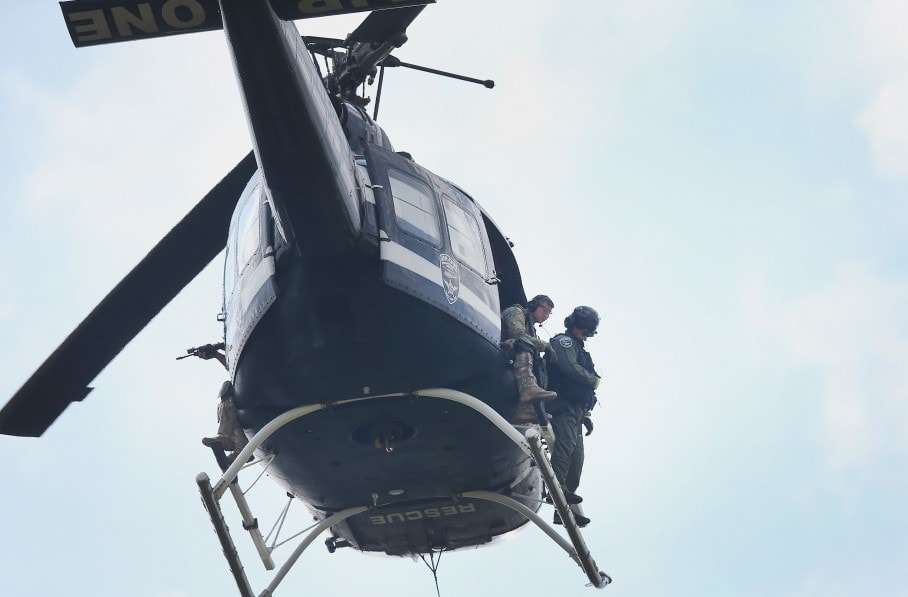The Volokh Conspiracy
Mostly law professors | Sometimes contrarian | Often libertarian | Always independent
Helicopter (and drone?) surveillance and the Fourth Amendment

The Supreme Court has held that observing and photographing people's homes and surrounding areas from an airplane, flying at 1,000 feet, doesn't violate the Fourth Amendment (see California v. Ciraolo (1986)). It also held the same as to a helicopter overflight at 400 feet (Florida v. Riley (1989)), though there one of the justices whose vote was necessary for upholding the government action (Justice O'Connor) noted that "public use of altitudes lower than that - particularly public observations from helicopters circling over the curtilage of a home - may be sufficiently rare that police surveillance from such altitudes would violate reasonable expectations of privacy, despite compliance with FAA air safety regulations."
Monday, the New Mexico Supreme Court (in State v. Davis) held that an overflight by a helicopter at 50 feet violated the Fourth Amendment. But its analysis focused less on the usual inquiry in Fourth Amendment cases - the gathering of information that a person would have liked to keep hidden - and more on the physical intrusiveness of the helicopter:
[W]hen low-flying aerial activity leads to more than just observation and actually causes an unreasonable intrusion on the ground - most commonly from an unreasonable amount of wind, dust, broken objects, noise, and sheer panic-then at some point courts are compelled to step in and require a warrant before law enforcement engages in such activity. The Fourth Amendment and its prohibition against unreasonable searches and seizures demands no less…
The district court's findings make multiple references to the degree of noise and disturbance on the ground and suggest that the helicopter swooped down low enough to cause panic among the residents.
In addition to the district court's findings, evidence from Davis and the other residents suggests that the officers in the helicopter did more than merely observe. There were multiple allegations regarding other properties that the helicopter caused property damage - the broken beams and the damaged solar panel - and produced excessive noise and kicked up dust and debris. The noise allegations in particular are supported by Sergeant Merrell's audio recording where the helicopter is clearly heard hovering over Davis' home. And it is clear from all testimony that the helicopters were there to do more than just observe; they were also there to provide aerial cover and protection for the officers on the ground - in other words, to participate actively in the investigation. In so doing, the police increased the risk of actual physical intrusion as occurred in this case.
Of course, the question then is what happens with drones, which can fly very low without causing much noise or damage. The intermediate appellate court in the case had discussed them, in concluding that physical intrusiveness (as opposed to intrusion on informational privacy) shouldn't matter:
We fail to see how an analysis of intrusiveness factors aids in the determination of whether an aerial surveillance is a search. The privacy interest protected by Article II, Section 10 is not limited to one's interest in a quiet and dust-free environment. It also includes an interest in freedom from visual intrusion from targeted, warrantless police aerial surveillance, no matter how quietly or cleanly the intrusion is performed. Indeed, it is likely that ultra-quiet drones will soon be used commercially and, possibly, for domestic surveillance. Such advances in technology demonstrate the increasingly diminished relevance of intrusiveness factors, as courts have regarded them in the past, in the analysis of what constitutes a search.
But the New Mexico Supreme Court disapproved of the intermediate court's analysis:
As an aside, we note that the Court of Appeals, when reviewing the district court's order in this case, suggested that when considering privacy interests under our State Constitution we move away from an intrusion analysis in anticipation of future surveillance conducted by "ultra-quiet drones" and other high-tech devices. Because this case only involves surveillance by helicopters, technology that has been with us for nearly 80 years, we find it unnecessary to speculate about problems - and futuristic technology - that may or may not arise in the future. Instead, we reserve judgment and await a proper case with a developed record.
The New Mexico Supreme Court's decision also canvasses some cases from other states dealing with helicopter surveillance. Very interesting stuff, for anyone concerned about the Fourth Amendment and aerial surveillance (whether by helicopters or drones).



Show Comments (0)